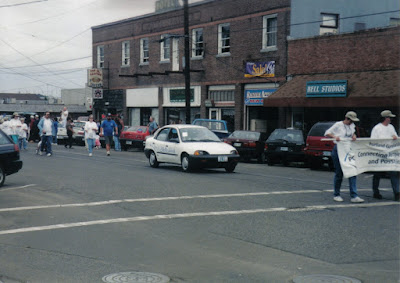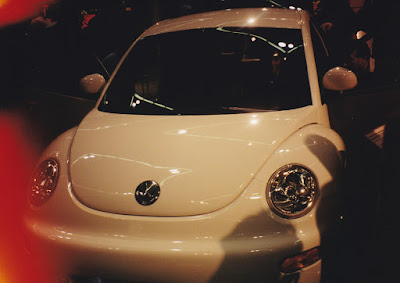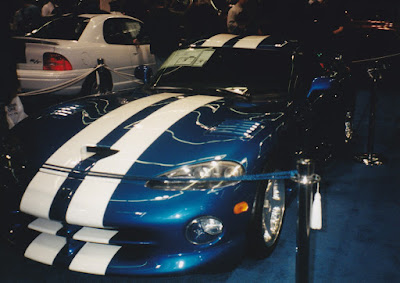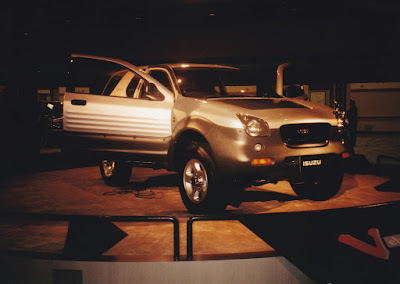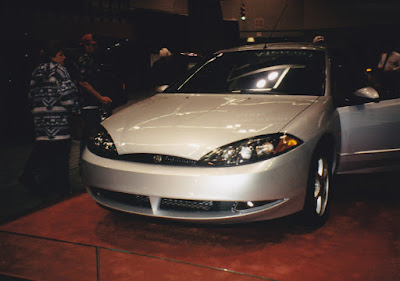Thursday, July 5, 2018
1996 Solectria Force
This may look like a Geo Metro sedan, but, in fact, it is an electric car called a Solectria Force. In the 1990s, the Solectria Corporation of Wilmington, Massachusetts, built approximately 400 of these electric cars from brand-new, motor-less 1996 Geo Metros. In place of the gasoline engine and transmission, Solectria installed a 56-horsepower 40-kilowatt three phase alternating current electric motor and a total of 13 12-volt lead-acid gel batteries under the hood and in the trunk. The Solectria Force could reach a top speed of 70 miles per hour, and accelerate from 0 to 30 miles per hour in 8 seconds and 0 to 60 miles per hour in 18 seconds. It had a typical range of 35 to 50 miles on a charge, though one Solectria Force driver set a record of 110 miles on a single charge. With an on-board charger, the Solectria Force could be fully charged in 2.5 hours from a 240-volt outlet or 12 hours from a 110-volt outlet. The Solectria Force also featured advanced regenerative braking, using the car's front wheels to turn the electric motor when coasting or decelerating, using it as a generator to help recharge the batteries and extend the range between charging.
The Solectria Force pictured here belonged to Portland General Electric, which purchased two of the electric cars for its own company fleet. They made appearances at schools and at community events like the Days in the Park Parade in Rainier, Oregon, on July 11, 1998.
Labels:
1996,
Electric,
Rainier 1998,
Solectria
1989 Toyota MR2
The Toyota MR2 was introduced in June 1984 for the 1985 model year. The name MR2 may refer to the car's mid-engine layout, rear-wheel drive and two seats. The first-generation MR2 was powered by a 112-horsepower 1,587 cubic centimeter dual overhead-cam inline four-cylinder engine. A 145-horsepower turbocharged version was introduced in 1988 in the United States. The T-Bar roof as seen on this example was introduced in 1987. For 1989, the final year of the first generation model, the side mirrors and door handles matched the paint color.
Labels:
1989,
Rainier 1998,
Toyota
Wednesday, July 4, 2018
M88A1 Medium Recovery Vehicle
 |
| Rear View of the M88A1 |
The M88 was originally introduced in 1961 as an armored recovery vehicle for the M48 Patton tank. It was manufactured by Bowen McLoughlin York in York, Pennsylvania, and was powered by a 980-horsepower Continental V-12 supercharged gasoline engine, with a 10-horsepower gasoline auxiliary power unit. The M88A1 was introduced in 1977 as a recovery vehicle for the new M60 tank, and is powered by a 750-horsepower Continental V-12 twin-turbo diesel engine, with a 10-horsepower diesel auxiliary power unit. In addition to newly-built M88A1s, the existing M88s were converted to the new design. Over 3,000 were built for the United States Army and Marine Corps, however they lacked the capacity to recover the M1 Abrams tank, and have since been replaced by the new M88A2.
Labels:
Military
1942 International-Harvester M-1-4 Ambulance
The International-Harvester M-1-4 is a 1/2-ton truck that was introduced in 1941 and was used exclusively by the United States Navy and Marine Corps. This example from 1942 is a field ambulance with a collapsible ambulance body built by the Boyertown Auto Body Works of Boyertown, Pennsylvania. One of the very few survivors of the nearly 900 built, it is now displayed at the Boyertown Museum of Historic Vehicles. The M-4-1 was also available as a cargo truck with removeable troop seats and sometimes fitted with a canvas top. It was replaced in 1942 by the 1-ton M-2-4, which was nearly identical in appearance.
Labels:
1942,
Ambulance,
International-Harvester,
Military
Sunday, July 1, 2018
1997 General Motors EV1
This terrible picture is one that I really wish had turned out, as it shows a General Motors EV1 at the 1998 Portland International Auto Show in Portland, Oregon, the only one I've ever seen. The EV1 was introduced in 1996 as a 1997 model, and was the first modern mass-produced purpose-designed electric car from a major automaker. Powered by a 137-horsepower 3-phase AC induction electric motor with lead-acid batteries, the two-seat EV1 had a standard range between charges of 65 miles in the city to 95 miles on the highway. The EV1 was available only as a three-year lease through select Saturn dealers in California and Arizona, at a cost of about $399 per month in California and about $549 per month in Arizona. This car is apparently a 1997 model, as there were no 1998 models built. The 1999 EV1 would feature improved lead-acid batteries, plus optional Nickel metal hydride batteries (available only in California at a cost of $499) that increased the range to 75 to 140 miles between charges, and allowed the EV1 to accelerate from 0 to 60 miles per hour in under 8 seconds. The EV1 program was also expanded to Atlanta, Georgia, and additional parts of California. The reason for this EV1 appearing in Portland is unclear. The EV1 was never available for lease in Portland, but perhaps Portland was a potential future market General Motors had been considering for the EV1. As it turned out, production of the EV1 would end in 1999 after a total of 1,117 cars, and General Motors would soon stop offering lease renewals to reclaim them. By the end of 2003, all of the EV1s were off the road. A few were donated to universities and museums; the rest were crushed.
Labels:
PIAS 1998
1998 Volkswagen New Beetle
A newcomer for 1998 was the all-new retro-styled Volkswagen New Beetle, which got a lot of attention. Production of the New Beetle began December 1997 at Volkswagen’s plant in Puebla, Mexico, the sole source. Based on Volkswagen’s Golf chassis, it was scheduled to be on sale in the United States by the end of March 1998. Exports to Europe were scheduled for Fall 1998, and the rest of the world in 1999. Based on the Volkswagen Concept 1 that was presented at the 1994 North American International Auto Show in Detroit, Michigan. The base model starts at $15,700 with a 115-horsepower 2.0-liter inline 4-cylinder gasoline engine and a 5-speed manual transmission. A 90-horsepower 1.9-liter 4-cylinder Turbo Direct Injection diesel engine was also available, starting at $16,975. A 150-horsepower turbocharged 1.8-liter engine would become available in the fall of 1998. Unlike Volkswagen’s original Beetle, which featured an air-cooled, rear-mounted engine, the New Beetle is front wheel drive with water-cooled engines mounted in the front. With a wheelbase of 98.9 inches, the New Beetle is 161.1 inches long and 67.9 inches wide. Standard features include a fully galvanized body for rust protection, dual front airbags and front seat-mounted side airbags, four-wheel disc brakes, pretensioning front safety belts, front and rear headrests, halogen projector-beam headlights, daytime running lights, air conditioning, pollen and odor filter, six speaker stereo, beverage holders, antitheft alarm system, central locking system with remote, and even a bud vase. Available options included anti-lock brakes, alloy wheels, cruise control, leather upholstery, fog lamps, heated front seats, and power windows.
Labels:
1998,
New Beetle,
PIAS 1998,
Volkswagen
Dodge Dakota Sidewinder
The Dodge Dakota Sidewinder is a concept truck that was created in 1997, combining the styling cues of the 1997 Dodge Dakota like the offset hood, fenders, and cross hair grille, with those of classic trucks of the 1920s, 1930s, and 1940s, like a bucket-shaped cab, a narrow 4’ x 6’ box, a billet-style headerless windshield, and a lack of visible door handles, bumpers and trim. The Dakota Sidewinder is essentially a pickup-version of the Dodge Viper, using the Viper GTS-R’s 8.0-liter V-10 engine, with more than 600 horsepower and 700 foot-pounds of torque, in a rear-wheel-drive pickup. Unlike the Viper, the Dakota Sidewinder has a four-speed automatic transmission, but can still accelerate from 0 to 60 miles per hour in under 4 seconds and reach a top speed of 170 miles per hour. The Dakota Sidewinder has a 112-inch wheelbase and an overall length of 189 inches, with a height of only 56 inches and a curb weight of only 2,700 pounds. The Dakota Sidewinder features a front double wishbone and rear five-bar link suspension for lower ride and sports-car-like handling. It rides on cast aluminum wheels that measure 8 inches by 21 inches in the front and 11 inches by 22 inches in the rear, and features a four-wheel anti-lock braking system with 15-inch disc brakes.
1998 Lincoln Town Car
The Lincoln Town Car was redesigned with a new aerodynamic body in 1998, the same body that it would continue to use for the next decade with little change, along with a new interior and larger brakes. The rear-wheel-drive Lincoln Town Car was powered by a 4.6-liter single overhead cam V8 engine that produced 205 horsepower. The top-of-the-line Cartier trim level featured dual exhaust and increased the power to 220 horsepower, enough to accelerate the 4,000-pound Town Car from 0 to 60 miles per hour in 7.9 seconds and reach a top speed of 130 miles per hour.
1998 Dodge Viper GTS
The Dodge Viper was first sold in 1992, and was originally only available as a roadster. In 1996, the Viper saw a facelift, and the Dodge Viper GTS coupe was introduced. The body of the GTS was made almost entirely of composite materials, resulting in the GTS weighing 42.2 pounds less than the roadster, despite the addition of a solid roof. The Viper GTS was powered by a 488-cubic-inch Lamborghini-designed all-aluminum V10 engine that produced 450 horsepower and 490 foot-pounds of torque and featured a six-speed manual transmission. The Viper GTS could accelerate from 0 to 60 miles per hour in 4.7 seconds, cover a quarter-mile in 12.6 seconds at 117 miles per hour, and reach a top speed of 179 miles per hour. The Viper GTS featured 23-inch vented disc brakes at all four corners and had 17-inch alloy wheels that were 10 inches wide in the front and 13 inches wide in the rear. Despite not being changed much for 1998, the Dodge Viper was still really cool. Changes for 1998 included a reduced overlap camshaft for smoother idle with increased spark advance without raising emissions, stainless steel exhaust manifolds that were 24 pounds lighter than the previous cast iron components, and second generation airbags.
Jeep Icon
The Jeep Icon concept car was created in 1997 to explore the styling possibilities of future Jeep Wrangler models. The Icon was designed as a unibody construction with an integrated aluminum roll cage. Chrysler designers widened the Wrangler’s track, reduced its length by 5 inches to 142 inches, reduced its overhangs by 2 inches, and increased wheel travel from 8 inches to 10 inches. They increased the size of the bumpers, tires and wheel arches for a compact, muscular look. Traditional Wrangler design elements were retained, including the general proportions, exposed hinges, bold bumpers, exposed door handles and gas cap, folding windshield, and the classic grille, which was made shorter and wider. The hinges, door handles, wheels and bumper were all branded with the Jeep logo. Inside, the seats were inspired by the design of a camper’s backpack, made of lightweight exposed aluminum tubes and waterproof olive-gray leather upholstery.
1998 Chevrolet Camaro
The fourth generation of the Chevrolet Camaro was introduced in 1993, and In 1998 the Chevrolet Camaro was given a facelift, with aerodynamic flush headlights replacing the recessed headlights that had been a Camaro trademark since the previous generation debuted in 1982. The Camaro's base engine was still the 200-horsepower 3.8-liter V6, but the Z28 and SS featured an all-new aluminum-alloy 5.7-liter LS1 small block V8. The LS1 has the same bore spacing as the LT1 it replaced, but is shorter and lighter, with longer intake runners, a winged oil pan, a .500-inch lift hydraulic roller camshaft, wider camshaft journals, and a coil for each cylinder. The LS1 is rated at 305 horsepower in the Camaro Z28, but with the ram air induction of the Camaro SS is boosted to 320 horsepower, enough to accelerate the Camaro SS from 0 to 60 miles per hour in 5.3 seconds and reach a top speed of 161 miles per hour.
1998 Ford Escort ZX2
The Ford Escort had been redesigned for 1997, but 1998 saw the addition of the all-new Ford Escort ZX2 coupe. The sporty Escort ZX2 took the place of the Ford Probe, and was powered by a 130-horsepower 2.0-liter double overhead cam Zetec inline four-cylinder engine that was not available in the other Escort models. The Escort ZX2 could accelerate from 0 to 60 miles per hour in 7.4 seconds.
Hystar Airship
This isn't an automobile, but it was at an auto show. The Hystar Airship is a radio-controlled “flying saucer” spanning 18 feet in diameter. The Hystar couldflay straight up and down, hover in a stationary position, stop in midair, move sideways, and spin in any direction. The Hystar Airship dated back to at least 1986, when it appeared at Expo 86 in Vancouver, British Columbia. This photograph was taken over a decade later, during a demonstration at the 1998 Portland International Auto Show inside the Oregon Convention Center in Portland, Oregon.
Labels:
PIAS 1998
Isuzu VehiCROSS
The Isuzu VehiCROSS came to America as a 1999 model, and this very-limited production sport-utility vehicle was essentially a concept car. The VehiCROSS was shown at the New York International Auto Show in April 1997, and was being studied for a U.S. release. It was already on sale in Japan, where it had a sticker price of about $24,000, and expected sales of about 3,000 units a year. It is based on the Isuzu Trooper platform and built at the Fujisawa plant. The VehiCROSS is powered by a new 210-horsepower 3.2-liter dual overhead cam, direct injection V6 that produces 205 foot-pounds of torque. Other features include a torque-on-demand system that automatically distributes power between the front and rear wheels depending on conditions, a color rear-view video camera with a 5-inch monitor mounted on the instrument panel that can also be linked to a global navigation system, aluminum shock absorbers with increased damping efficiency and separate tanks for the oil and gas inside the shock, a 17-inch spare tire integrated into the design of the rear tailgate, a Momo steering wheel, Recaro seats, power windows, air conditioning, heated mirrors, and dual airbags.
1999 Mercury Cougar
The Mercury Cougar was originally introduced in 1967, and continued uninterrupted until the rear-wheel drive Thunderbird-based Cougar ended production in 1997. After a one-year absence, this new, very different Cougar would appear as a 1999 model. Based on the Mercury MC2 concept car from 1997, the new Cougar was introduced at the 1998 North American International Auto Show in Detroit, Michigan, and was scheduled to go on sale in May 1998. Based on the Ford Contour and Mercury Mystique, the new Cougar shares about 70 percent of its parts with the sedans, including the chassis, engines and transmissions. Unlike the sedans, the new Cougar is a front-wheel drive, four-seat, two-door hatchback, and is Mercury’s first production model to feature its New Edge design, which is based on using distinct creases to accent rounded and flowing shapes. Bold, sheer surfaces are accented by a sharp, rising belt line that starts at the front bumper and extends to the rear, ending at the rear bumper and the shardlike triangular wraparound tail light lenses. The New Edge designs allows for minimal spacing between the bumper moldings and the sheet-metal panels, and crisp corners where the hood meets the darkened lenses of the four-beam projector headlights. The Cougar is available with a 125-horsepower 2.0-liter dual overhead cam inline 4-cylinder engine or a 170-horsepower 2.5-liter 24-valve dual overhead cam Duratec V6, with either a standard 5-speed manual or optional 4-speed automatic transmission. The Cougar comes standard with anti-lock brakes and front air bags, with optional side airbags mounted in the side of the front seats.
1999 Ford F-250 Super Duty
Though Ford’s regular F-150 and F-250 were all new in 1997, the all new Super Duty trucks were not available until 1999. The Super Duty F-250 replaced the F-250 (based on the new F-150) and the F-250 HD (a continuation of the previous F-250) while the F-350 Super Duty replaced the previous F-350. The standard engine was a 255-horsepower 5.4-liter single overhead cam 16-valve Triton V8 gasoline engine that produced 350 foot-pounds of torque. Also available was a 310-horsepower 6.8-liter single overhead cam 20-valve V10 Triton gasoline engine that produced 425 foot-pounds of torque. Both Triton engines featured a new “limp home” mode that allows the truck to be driven a short distance even if all coolant has been lost, accomplished by the engine control computer alternately shutting off fuel to half of the cylinders, allowing them to pump air to keep the engine cool. A 235-horsepower 7.3-liter Power Stroke V8 diesel engine that produced 500 foot-pounds of torque was also available. Five-speed manual and four-speed automatic transmissions were available for all engines. The Super Duty trucks were available with a standard cab, a SuperCab, or a crew cab, and either a 6-3/4-foot or an 8-foot bed. Four wheel drive was available as an option on all models, and a dual-wheel rear axle was available for the F-350. Trim levels included the base XL, the mid-range XLT, and the top-of-the-line Lariat.
1998 Ford Crown Victoria
1998 was a big year for the Ford Crown Victoria, as it saw a major change to the styling of the aerodynamic body that debuted in 1992. In addition to major facelifts to the front and rear, the roofline and windows were also changed to match that of the Mercury Grand Marquis. The Crown Victoria would keep this same basic styling with very little change for the next decade. The Crown Victoria also received changed to its suspension, brakes and steering to give the car better handling while maintaining a smooth ride, including the addition of a Watt’s linkage to the rear axle to help prevent the axle from swaying during turns or acceleration. Other changes include increasing the size of the disc brakes by 1 inch to 16 inches, coil-on-plug ignition, an electric fan replacing the engine-driven fan, and a new “limp home” mode that allows the car to be driven a short distance even if all coolant has been lost, accomplished by the engine control computer alternately shutting off fuel to some of the cylinders, allowing them to pump air to keep the engine cool. An optional all-speed traction control replaces the previous low-speed traction assist system. The Crown Victoria is still powered by the same 200-horsepower 4.6-liter V8 as before, though the less restrictive dual exhaust included with the optional handling package allows it to produce 215 horsepower.
Labels:
1998,
Crown Victoria,
Ford,
PIAS 1998
Subscribe to:
Posts (Atom)





